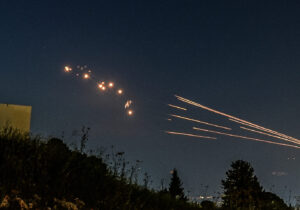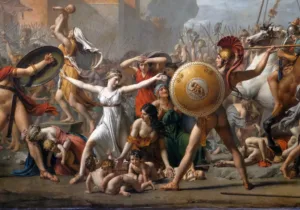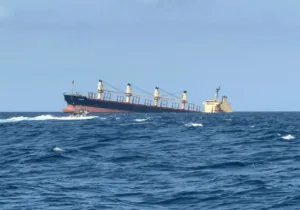President Barack Obama evoked howls of disapproval from his opponents when, in early 2009, he bowed before King Abdullah Bin Abdulaziz, the absolute ruler of Saudi Arabia.
Critics pointed out at that time that no President had ever bowed to any foreign prince or potentate. This high profile encounter—the President was attending a G-20 Summit in London—provided a marked contrast with the almost entirely overlooked first meeting of a President and the monarch of the Desert Kingdom.
President Franklin D. Roosevelt was on his return trip from his last meeting with the World War II “Big Three” leaders. He had met Soviet Marshal Josef Stalin and British Prime Minister Winston Churchill at the Crimean resort of Yalta. It had been an exhausting 14,000-mile journey for the obviously ailing Roosevelt. Weeks and days were required to cross the Atlantic and the Mediterranean, and, arriving in the battle-battered USSR, the President had to endure a jolting five-hour drive by automobile to the Yalta conference site.
FDR’s appearance at the Yalta Summit shocked many of the American military and diplomatic staff who had not seen him in months. “He was not only frail and desperately tired, he looked ill. I never saw Roosevelt look as bad as he did then,” said Charles “Chip” Bohlen, a veteran U.S. Foreign Service officer.[i]
Nonetheless, Roosevelt was determined to be “up” for his first meeting with the Desert King. Saudi Arabia was then considered to be in the British sphere of influence. But with the exhaustion of British military and economic resources occasioned by the desperate struggle with Germany, the British were obviously unable to continue to “punch above their weight” (Churchill’s phrase). The last summit of the Big Three had been, as more realistic British participants said, more like a meeting of the Big Two-and-a-Half.
Roosevelt was determined to keep the reins of power in his own hands, even if those hands visibly shook. King Ibn Saud (Abdulaziz) was the founding monarch, the warrior chieftain whose sword had brought warring tribes of Arabia under his and his family’s rule. Only in the 1920s had he “pacified” the Arabian Peninsula and expelled the rival Hashemite tribe. (These were enthroned in Iraq and Trans-Jordan under British sponsorship). The nation that would soon be renamed Saudi Arabia was ruled by Abdulaziz, with dynastic succession assured by the forty-two sons he sired by his numerous wives and concubines. Among Arabs, he was said to have conquered the peninsula “with a sword of steel and a sword of flesh.”
To bolster his throne, the King relied on the support of the zealous clerics of the Wahhabi sect, one of the most stringent of all Islam. Religious police kept the restive population in check, and regular Friday afternoon beheadings—after Mosque worship and in the public square—provided a sharp warning of the cost of dissent.
The King would meet Roosevelt at the Great Bitter Lake, in Egypt. It was the first time he had left Mecca to confer with any foreign leader. To make his appointment in Egypt, the King would travel aboard the USS Murphy. That Navy vessel would carry him to a rendezvous with the American Commander-in-Chief aboard the USS Quincy.
The King declined the stately quarters prepared for him on board Murphy, in part because his crippling arthritis made ascending and descending ship’s ladders an agony for the aging monarch. Instead, he and his retinue rode on the ship’s fantail (stern), the King seated under a lavish tent on his elaborate golden throne. He remained there, looking straight ahead as the Murphy steamed toward her date with history. The only times he left his throne were for regular prayers. The ship’s navigator helpfully provided the compass heading for the direction of Mecca.
Waiting on the Quincy, President Roosevelt told his daughter, Anna, to take a day ashore, shopping in the Arab souk (market). Strict Muslim protocol did not then permit women to take part in affairs of state. (No one, apparently, had told the King the Murphy on which he was conveyed was a “she.”)
As the two leaders met, Roosevelt seemed to come alive. He had relied on his personal charisma and undoubted charm to deal with rulers more temperamental and mercurial than this desert despot. He had dealt throughout the war with Churchill, De Gaulle, Chiang Kai-shek, and Stalin. Abdulaziz’s country—a cobbled together kingdom of fewer than 16 million Arabs and Bedouins—should not have challenged Roosevelt’s deft diplomacy. Or so the President may have thought.
The first summit opened cheerily enough. The exchange of gifts provided exotic entertainment. The King gave the President fine robes, worked leather, and rare objects. But he was most delighted to receive from Roosevelt one of the President’s own spare wheel chairs. FDR had to think fast, however, to avoid offending the King. Abdulaziz was so happy with the meal provided him that he wanted to have the President’s expert Filipino chef as his own servant. (“No, no, NO!” the chef was heard to yell as he disappeared into the bowels of the Navy destroyer.)
Attended by bare-footed Nubian slaves with naked scimitars, the King was even more enchanted when the President gave him an American DC-3 airplane. By 1945, these cargo planes were rolling off American assembly lines at the rate of thousands per week. Still, the King had never flown in an airplane.
The entire encounter—the first between an American President and a Saudi ruler—was something out of Arabian Nights. Accompanied by slaves, relatives, translators, and other retainers, the King manifested a natural dignity not unlike that ascribed to American Indian chieftains who had met Presidents throughout our history…
Read the second half the story about when Franklin D. Roosevelt met King Ibn Saud and how U.S.-Saudi Arabia relations were shaped by this meeting.
Robert Morrison is a former Reagan official and senior fellow at the Family Research Council who blogs from Annapolis.
Photo Credit: Wikimedia Commons, U.S. Navy. FDR Meets with King Ibn Saud, of Saudi Arabia, on board USS Quincy (CA-71) in the Great Bitter Lake, Egypt, on 14 February 1945. The King is speaking to the interpreter, Colonel William A. Eddy, USMC. Fleet Admiral William D. Leahy, USN, the President’s Aide and Chief of Staff, is at left.
[i] Hamby, Alonzo, Man of Destiny: FDR and the Making of the American Century, Basic Books, New York: 2105, p. 420.






 Live in the DC area? Sign-up for Providence's in-person events list!
Live in the DC area? Sign-up for Providence's in-person events list!